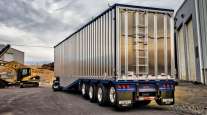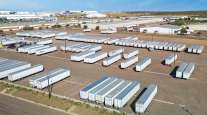Senior Reporter
Demand for Rental, Lease Trailers at Historic Highs

[Ensure you have all the info you need in these unprecedented times. Subscribe now.]
The utilization rate of rental and lease trailers continues at historic highs amid industry consolidation and a shift to more rentals and away from long-term leases, according to an industry survey released in August.
WillGo Transportation Consulting surveyed 62 independently owned and operated van, reefer and flatbed rental and lease fleets with 500 trailers or more in North America. The survey excluded full-service lessors, financial lessors and dedicated intermodal chassis lessors, whose primary business is not the rental or leasing of trailers.
“Everyone, myself included, was braced for a downturn in utilizations during 2020. Typical [trailer] fleet utilizations have been running in the mid to high 90s for nearly eight years now. That is historically unheard of in the trailer rental-lease business which used to run around 80% combined overall annual utilization, and was both very cyclical and seasonal,” WillGo CEO Charles Willmott told Transport Topics.

Willmott
That lower level of usage appeared ready to return in the weakening freight environment as 2020 began, but the outlook changed when the pandemic-driven March shutdown of the economy stranded freight in the pipeline, he said.
“Rental-lease yards got emptied out almost immediately by shippers and carriers who needed to store freight with no place to go due to factory and store closures. All the major warehouses were already full. That demand has not let up ever since even though freight has started to move again,” Willmott said.
E-commerce also boosted the need for more trailers and prompted an operational redistribution of trailers already in service — especially in the less-than-truckload and local delivery segments, he said.
A second surprising aspect of the trailer lease-rental business now, Willmott said, is the increase in the percentage of rentals versus long-term leases, and how lenders have accepted that shift.
Interest in the greater security of a large long-term lease portfolio “seems to have dissipated after an unprecedented stretch of high rental demand and utilization. Lenders have become comfortable thinking this is the new norm,” he said.
“Long-term leases traditionally gave lenders and investors the security of knowing that cash flow would be less subject to the ebbs and flows of the rental market,” he added.
Meanwhile, WillGo restated its 2019 trailer population results downward to 518,000. The 2020 tally came to 550,000, coincidentally the same as the original 2019 estimate, representing a 6% growth in the total North American rental-lease fleet year over year, he said. The final 2020 results included 11 Canadian and 51 U.S. fleets of 500 or more trailers, down slightly from 67 North American fleets in 2019 due primarily to industry consolidations — which Willmott expects to continue.
At the same time, the survey found there was some minor shifting in the size of the trailer fleets — growth in the number of fleets in the 1,000 to 9,999 trailer range, and a corresponding decrease in smaller fleets with 500 to 999.
Our 2020 North American Trailer Rental & Lease Fleet Survey final report is now available. If you are interested, you... Posted by WillGo Transportation Consulting on Monday, August 31, 2020
Dry vans dominate North American rental-lease portfolios, accounting for an estimated 80% of the mix.
Based on a North American population of 550,000 trailers, the total asset value of the industry is conservatively estimated in excess of $8 billion with annual revenue of more than $1.5 billion, according to the survey.
The survey, the second WillGo has performed, is intended to correct a situation where trailer rental-lease fleet owners have had very little available market intelligence to guide their planning and business decisions, Willmott said.
Want more news? Listen to today's daily briefing:
Subscribe: Apple Podcasts | Spotify | Amazon Alexa | Google Assistant | More




